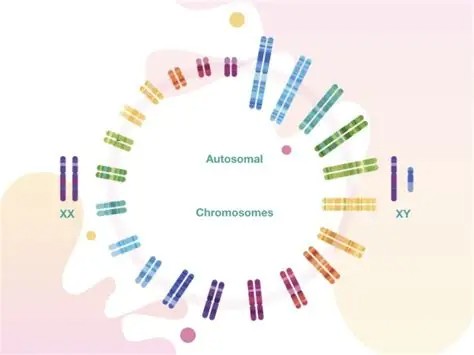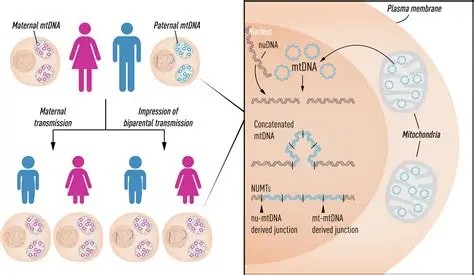Introduction
When most people think about genetics and how traits are passed from parents to offspring, they usually picture the genes located on chromosomes inside the nucleus of a cell. These nuclear genes follow well-established patterns of inheritance, known as Mendelian inheritance. However, this is not the only way genetic information can be inherited. There is another fascinating form of inheritance known as extrachromosomal inheritance, which refers to the transmission of genetic material that is not found within the nucleus but instead resides in other parts of the cell, especially the cytoplasm. This genetic information is usually found in specialized organelles like mitochondria, chloroplasts, or even in smaller DNA elements called plasmids.

This form of inheritance is particularly significant because it follows different rules than nuclear inheritance and has many implications in health, biotechnology, agriculture, and evolutionary biology. This document provides a comprehensive, humanized explanation of extrachromosomal inheritance. We will explore what it is, where it occurs, the different types and modes through which it operates, and its wide range of applications.
Table of Contents
What is Extrachromosomal Inheritance?
Extrachromosomal inheritance, also known as cytoplasmic inheritance, is a mode of genetic transmission where traits are passed down from one generation to another not through nuclear chromosomes, but via DNA located outside the nucleus. This DNA is found in the cytoplasm and is carried by organelles such as mitochondria and chloroplasts, or as plasmids in bacteria and fungi.
Unlike Mendelian inheritance, which follows patterns involving dominant and recessive genes from both parents, extrachromosomal inheritance often shows uniparental inheritance, especially from the mother. This is because the egg cell contributes most of the cytoplasm to the zygote, while the sperm contributes very little. As a result, the DNA in organelles like mitochondria and chloroplasts is usually inherited only from the mother.

This form of inheritance challenges the classical view that all genetic information is stored in nuclear chromosomes. It reveals that important traits, especially those related to metabolism and adaptation, can be controlled by genes outside the nucleus.
Sources of Extrachromosomal DNA
There are several key places where extrachromosomal DNA can be found in cells. These sources are crucial to understanding the different roles and inheritance patterns of this type of genetic material:

- Mitochondria: These are the energy-producing structures in nearly all eukaryotic cells. They contain a small circular DNA genome that codes for proteins involved in cellular respiration.
- Chloroplasts: Found in plant cells and algae, chloroplasts carry DNA that encodes for proteins necessary for the process of photosynthesis.
- Plasmids: These are small, circular DNA molecules present in bacteria and some fungi. They replicate independently of the chromosomal DNA and often carry genes that provide advantages like antibiotic resistance.
- Double-minute chromosomes: Found in some cancer cells, these are small fragments of extrachromosomal DNA that can carry amplified oncogenes, which promote uncontrolled cell growth.
Each of these extrachromosomal elements has unique roles, replication methods, and patterns of inheritance, making them important subjects of study in various biological disciplines.
Key Features
Extrachromosomal inheritance is characterized by several unique features that distinguish it from nuclear inheritance. These features are vital for understanding how it works and why it matters:
- Independent replication: Extrachromosomal DNA elements, such as mitochondrial and chloroplast genomes or plasmids, can replicate on their own without being linked to the division of the nucleus. This means they can increase in number independently of nuclear DNA.
- Maternal inheritance: Because the egg cell provides most of the cytoplasm to the embryo, most extrachromosomal inheritance is maternal. This results in traits that are passed from the mother to all her offspring, regardless of the father’s genetic contribution.
- Circular DNA structure: Unlike the linear chromosomes found in the nucleus, most extrachromosomal DNA is circular in shape, which allows it to replicate more efficiently and resist damage.
- Critical biological functions: Genes in mitochondria and chloroplasts control essential processes like energy production and photosynthesis. Plasmids in bacteria can carry genes for antibiotic resistance or toxin production, affecting survival and adaptation.
Types of Extrachromosomal Inheritance
1. Mitochondrial Inheritance
Mitochondrial DNA (mtDNA) is found in the mitochondria, the cell’s energy-producing organelles. Each mitochondrion contains multiple copies of a small circular DNA molecule, which encodes proteins essential for the electron transport chain and ATP production.

- Inheritance pattern: Mitochondrial DNA is inherited only from the mother in most organisms. During fertilization, the mitochondria from the sperm are either destroyed or fail to enter the egg.
- Mutations: Changes in mitochondrial DNA can lead to a range of disorders, especially those affecting tissues that use a lot of energy, such as the brain, muscles, and heart.
- Examples: Leber’s Hereditary Optic Neuropathy (LHON) causes sudden vision loss in young adults; Mitochondrial Myopathy results in muscle weakness and exercise intolerance.
2. Chloroplast Inheritance
Chloroplast DNA (cpDNA) exists in the chloroplasts of plant cells and algae. Like mitochondria, chloroplasts have circular DNA that codes for proteins used in photosynthesis.
- Inheritance: Most plants show maternal inheritance of chloroplasts. However, in some species, paternal or biparental inheritance has been observed.
- Role in photosynthesis: Chloroplast genes are crucial for converting light energy into chemical energy.
- Applications: Chloroplast engineering is being used in crop improvement, allowing scientists to introduce genes for pest resistance or increased yield.
3. Plasmid-Based Inheritance
Plasmids are small, self-replicating DNA molecules found mainly in bacteria but also in some eukaryotic cells like yeast.
- Functions: Plasmids often carry genes that help bacteria survive, such as those for antibiotic resistance, toxin production, or metabolism of unusual substances.
- Transfer: Plasmids can be passed from one bacterium to another through a process called conjugation, allowing for rapid spread of traits across a population.
- Importance in biotechnology: Plasmids are widely used as vectors in genetic engineering, where they carry foreign genes into host cells to produce proteins like insulin.
4. Endosymbiont Inheritance
Some organisms live inside the cells of other organisms in a mutually beneficial relationship. These are called endosymbionts, and they may carry their own DNA.
- Example: Wolbachia is a genus of bacteria that infects many insects and affects reproduction. It is passed maternally and can change mating patterns, influencing population dynamics.
- Evolutionary implications: Endosymbionts may eventually become organelles, as suggested by the endosymbiotic theory of mitochondria and chloroplasts.
Modes of Extrachromosomal Inheritance
Extrachromosomal genes can be passed down through several modes, depending on the organism and the source of the DNA.
Maternal Inheritance
This is the most common form of extrachromosomal inheritance. Since the egg provides most of the cytoplasm during fertilization, the DNA in organelles like mitochondria and chloroplasts is passed from the mother.
- Implication: All children of an affected mother inherit the trait, while children of an affected father do not.
- Observed in: Humans, animals, and most plants.
Biparental Inheritance
In some cases, both parents contribute organellar DNA. This is rare but has been documented in certain plants.
- Outcome: Offspring have a mix of maternal and paternal organelle DNA.
- Example: Some algae and gymnosperms.
Paternal Inheritance
Extremely rare. In some species of algae, fungi, or even mammals, paternal inheritance of mitochondria has been observed, although it is often transient.
- Example: Occasional paternal leakage in mouse or human mitochondria.
Horizontal Gene Transfer (HGT)
In bacteria, plasmids can be shared between cells through conjugation, transformation, or transduction. This allows genes to spread even without reproduction.
- Importance: Plays a major role in antibiotic resistance.
- Example: Transfer of a resistance plasmid from one bacterial species to another.
Examples of Extrachromosomal Inheritance
1. Yeast “Petite” Mutants
In yeast, mutations in mitochondrial DNA can result in a condition known as the “petite” phenotype, where cells grow slowly and produce small colonies due to impaired energy metabolism.
2. Four-O’Clock Plants (Mirabilis jalapa)
In these plants, leaf color is inherited maternally. Some branches produce green leaves, others white, and some a mix. This is due to the inheritance of normal or mutant chloroplasts.
3. Bacterial Antibiotic Resistance
Bacteria carrying plasmids with resistance genes can survive antibiotic treatment and pass these plasmids to other bacteria.
4. Wolbachia in Insects
Wolbachia bacteria are inherited through eggs and can manipulate the reproduction of their host, sometimes preventing infected males from mating with uninfected females.
Uses of Extrachromosomal Inheritance
In Medicine
- Understanding diseases: Mitochondrial inheritance explains conditions that don’t follow Mendelian patterns.
- Gene therapy: New techniques aim to replace defective mitochondrial genes.
- Cancer research: Some tumors have extrachromosomal DNA that promotes growth.
In Agriculture
- Crop improvement: Chloroplast genes can be engineered to resist pests, herbicides, or harsh conditions.
- Containment: Since chloroplast DNA is maternally inherited, modified genes are less likely to spread to other species.
In Biotechnology
- Plasmids as tools: Plasmids are used in gene cloning, protein production, and vaccine development.
- Synthetic biology: Engineered plasmids help create customized organisms for industry or medicine.
In Evolution
- Endosymbiotic theory: Mitochondria and chloroplasts were once free-living organisms that became permanent cell residents.
- Tracing lineages: Mitochondrial DNA is used to trace maternal ancestry and human migration.
Advantages of Extrachromosomal Inheritance
- Efficient gene transfer: Plasmids can move quickly between cells.
- Adaptability: Extra genes can help organisms survive stress or antibiotics.
- Customizability: In biotechnology, extrachromosomal vectors allow targeted modifications.
- Evolutionary insight: Provides clues about the origin and adaptation of cells.
Disadvantages and Challenges
- Unpredictable inheritance: Organelles may segregate randomly during cell division.
- Mutational burden: Mutations in mitochondrial DNA can accumulate over time.
- Complex analysis: Studying extrachromosomal genes often requires specialized techniques.
- Limited coding capacity: Mitochondria and chloroplasts can only hold a few dozen genes.
Conclusion
Extrachromosomal inheritance presents an important but often overlooked aspect of genetics. It reveals how genetic information outside the nucleus can influence health, development, evolution, and biotechnology. Mitochondria, chloroplasts, and plasmids carry vital genes that work independently of the cell’s chromosomes, yet their contributions are essential.
As our understanding of these systems deepens, we gain powerful new tools to treat disease, improve agriculture, and study the fundamental principles of life. The study of extrachromosomal inheritance is not just a niche area of genetics—it is central to understanding how life operates on multiple levels.
Three Key Summary
- Extrachromosomal inheritance involves genetic material located outside the nucleus, such as in mitochondria, chloroplasts, and plasmids.
- This form of inheritance is typically maternal and plays crucial roles in biological functions, disease, and evolution.
- Extrachromosomal elements are powerful tools in medicine, agriculture, and genetic engineering.
FREQUENTLY ASKED QUEDSTIONS
What is extrachromosomal inheritance?
It is the passing down of genetic information located outside the cell nucleus, especially in mitochondria, chloroplasts, or plasmids.
Is mitochondrial DNA inherited from the father?
Generally, no. In most cases, mitochondrial DNA is inherited only from the mother because the egg provides the majority of the cytoplasm.
Why is this form of inheritance important?
It helps explain genetic diseases that do not follow traditional inheritance patterns, and it has practical uses in medical research and biotechnology.
Related Articles




